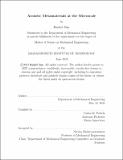| dc.contributor.advisor | Portela, Carlos M. | |
| dc.contributor.author | Sun, Rachel | |
| dc.date.accessioned | 2023-10-18T17:11:16Z | |
| dc.date.available | 2023-10-18T17:11:16Z | |
| dc.date.issued | 2023-06 | |
| dc.date.submitted | 2023-09-28T15:47:32.536Z | |
| dc.identifier.uri | https://hdl.handle.net/1721.1/152502 | |
| dc.description.abstract | Micro-architected materials allow for tunability of extreme static mechanical properties such as stiffness, Poisson’s ratio, or strength. However, dynamic and acoustic properties of micro-architected materials remain largely unexplored, partially because it is challenging to measure their response at these scales. Dispersion resulting from Bragg scattering occurs at wavelengths which are dictated by the characteristic dimensions of the metamaterials, while local resonance remains wavelength-independent. Therefore, micro-architected materials have the potential to allow control of mechanical waves both at high (MHz) and medium-range (kHz) frequencies.
Here, we design, fabricate, and characterize micro-architected materials with tunable mechanical and acoustic properties in the megahertz regime. Using a two-photon lithography prototyping method, we explore the response of a class of architected material morphologies with varied mass distribution, features down to ~1.5 µm, and unit cell sizes of 15 µm. We demonstrate that decoupling mass and stiffness by strategically placing micro-inertia affects the effective stiffness scaling of this class of acoustic metamaterials at the microscale. We present novel measurement techniques for wave velocity of three-dimensional architected materials that employ laser-ultrasonic principles, demonstrating a tunable range of wave velocities around 1000 m/s for different designs in a wide range of relative densities. We then validate their acoustic response numerically with Bloch wave analysis to determine their dispersion relation and rod-wave velocities. Our results provide a baseline to map the tunable acoustic metamaterial design space at the microscale and megahertz regime. These materials could have important implications in acoustic devices in microelectromechanical systems, biomedical imaging, and microscale waveguides. | |
| dc.publisher | Massachusetts Institute of Technology | |
| dc.rights | In Copyright - Educational Use Permitted | |
| dc.rights | Copyright retained by author(s) | |
| dc.rights.uri | https://rightsstatements.org/page/InC-EDU/1.0/ | |
| dc.title | Acoustic Metamaterials at the Microscale | |
| dc.type | Thesis | |
| dc.description.degree | S.M. | |
| dc.contributor.department | Massachusetts Institute of Technology. Department of Mechanical Engineering | |
| dc.identifier.orcid | https://orcid.org/0000-0001-6396-1720 | |
| mit.thesis.degree | Master | |
| thesis.degree.name | Master of Science in Mechanical Engineering | |
